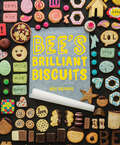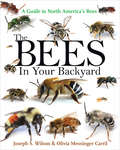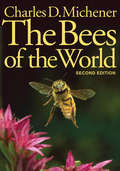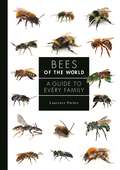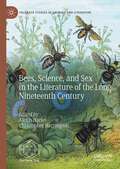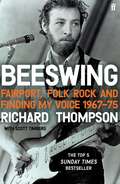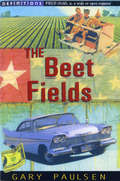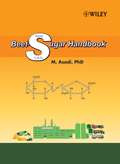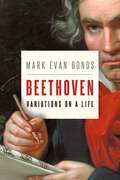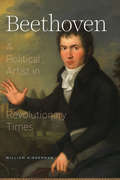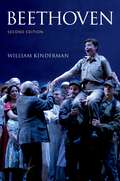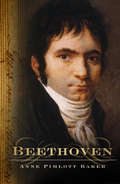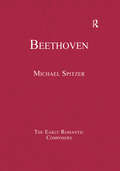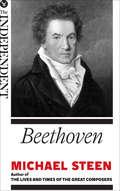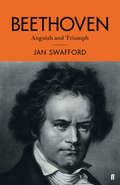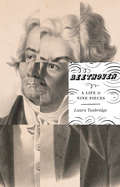- Table View
- List View
Bee's Brilliant Biscuits
by Bee BerrieBee Berrie of Bee’s Bakery is on a mission to bring unique biscuits and cookies into everyone’s life. She believes the secret to great baking is to give your bakes a personal edge. Her biscuits are original, colourful, flavourful and so much fun – she has a flair for bringing classic recipes bang up to date and her recipes are easily adaptable. Whether you want a sophisticated digestive to dunk in your tea, a personalized jammie dodger to give as a gift, cookies iced with crystallized edible flowers or an inky tattooed sea salt and brown butter cookie, you’ll find the recipe in this exciting book. A page of tear-out templates adds to the fun. All achievable for the home cook – with some aimed at children – and using easily sourceable ingredients, the 80 recipes will increase any baker’s repertoire. Bee makes the most unique biscuits around, raising eyebrows and smiles, all in one bite.
The Bees in Your Backyard: A Guide to North America’s Bees
by Joseph S. Wilson Olivia J. Messinger CarrilThe Bees in Your Backyard provides an engaging introduction to the roughly 4,000 different bee species found in the United States and Canada, dispelling common myths about bees while offering essential tips for telling them apart in the field.The book features more than 900 stunning color photos of the bees living all around us—in our gardens and parks, along nature trails, and in the wild spaces between. It describes their natural history, including where they live, how they gather food, their role as pollinators, and even how to attract them to your own backyard. Ideal for amateur naturalists and experts alike, it gives detailed accounts of every bee family and genus in North America, describing key identification features, distributions, diets, nesting habits, and more.Provides the most comprehensive and accessible guide to all bees in the United States and CanadaFeatures more than 900 full-color photosOffers helpful identification tips and pointers for studying beesIncludes a full chapter on how to attract bees to your backyard
The Bee's Kiss (Joe Sandilands #5)
by Barbara Cleverly1926, and Joe Sandilands is back from India, enjoying the frantic pleasures of Jazz Age London. Yet, there is a darkness behind all that postwar gaiety. A woman has been discovered bludgeoned to death in her suite at the Ritz. A broken window and missing emerald necklace suggest that it is a burglary gone wrong. But the corpse is that of a much-respected member of the British establishment, Dame Beatrice Joliffe, one of the founders of the Wrens, and so Scotland Yard send Joe to conduct a swift enquiry. Her companion, an ex-chorus girl, falls from Waterloo Bridge at twilight. Two of the Dame's clique of eager young Wrens commit suicide. All these deaths make Joe suspect that Beatrice has been killed by someone close to her but suddenly he finds that the case is closed and he is asked by his superiors to surrender his files. Against the background of the looming General Strike, and pressure from unseen governmental presences he struggles on, picking his way through the political panic and rebelling against authority, through to a shattering solution to the killings.
The Bee's Knees (Puffin Poetry Ser.)
by Roger McGoughA brilliant collection of brand-new poems from 'the patron saint of poetry'. Longer, narrative poems sit comfortably with Roger McGough's sharper observations and insightful words in this collection, perfectly illustrated in black-and-white line by Helen Stephens.
The Bees of the World
by Charles D. MichenerIn this extensive update of his definitive reference, Charles D. Michener reveals a diverse fauna that numbers more than 17,000 species and ranges from the common honeybee to rare bees that feed on the pollen of a single type of plant. With many new facts, reclassifications, and revisions, the second edition of The Bees of the World provides the most comprehensive treatment of the 1,200 genera and subgenera of the Apiformes. Included are hundreds of updated citations to work published since the appearance of the first edition and a new set of plates of fossil bees.The book begins with extensive introductory sections that include bee evolution, classification of the various bee families, the coevolution of bees and flowering plants, nesting behavior, differences between solitary and social bees, and the anatomy of these amazing insects. Drawing on modern studies and evidence from the fossil record, Michener reveals what the ancestral bee—the protobee—might have looked like. He also cites the major literature on bee biology and describes the need for further research on the systematics and natural history of bees, including their importance as pollinators of crops and natural vegetation. The greater part of the work consists of an unprecedented treatment of bee systematics, with keys for identification to the subgenus level. For each genus and subgenus, Michener includes a brief natural history describing geographical range, number of species, and noteworthy information pertaining to nesting or floral biology.The book is beautifully illustrated with more than 500 drawings and photographs that depict behavior, detailed morphology, and ecology. Accented with color plates of select bees, The Bees of the World will continue to be the world's best reference on these diverse insects.
Bees of the World: A Guide to Every Family (A Guide to Every Family #5)
by Laurence PackerA beautifully illustrated introduction to the incredible variety of bees from around the worldWhen many people think of bees, they are likely to picture the western domesticated honey bee, insects that live in large, socially complex societies inside a hive with a single queen and thousands of workers. But this familiar bee is just one of more than 20,000 species of bees—and almost none of the others is anything like it. In Bees of the World, Laurence Packer, one of the world’s foremost experts on wild bees, celebrates the amazing diversity of bees—from size and appearance to nests and social organization.Providing clear, accurate accounts of the seven bee families, Bees of the World presents all the key information on generic characteristics, habits, and habitat, illustrated with incredible and often rare photographs that show bees in their natural habitats—foraging, nesting, raising their young, and more. The book reveals the secrets of these extraordinary insects as well as their importance in the global ecosystem and the ways humans can help protect them.Provides a richly illustrated exploration of bees from around the worldExamines more than 100 genera of bees, giving a taste of the remarkable breadth of bee appearance and biologyExplores bee anatomy, behavior, classification, evolution, life cycle, and habitats
Bees, Science, and Sex in the Literature of the Long Nineteenth Century (Palgrave Studies in Animals and Literature)
by Alexis Harley Christopher HarringtonThe long nineteenth century (1789-1914) has been described as an axial age in the history of both bees and literature. It was the period in which the ecological and agronomic values that are still attributed to bees by modern industrial society were first established, and it was the period in which one bee species (the European honeybee) completed its dispersal to every habitable continent on Earth. At the same time, literature – which would enable, represent and in some cases repress or disavow this radical transformation of bees’ fortunes – was undergoing its own set of transformations. Bees, Science, and Sex in the Literature of the Long Nineteenth Century navigates the various developments that occurred in the scientific study of bees and in beekeeping during this period of remarkable change, focusing on the bees themselves, those with whom they lived, and how old and new ideas about bees found expression in an ever-diversifying range of literary media. Ranging across literary forms and genres, the studies in this volume show the ubiquity of bees in nineteenth-century culture, demonstrate the queer specificity of writing about and with bees, and foreground new avenues for research into an animal profoundly implicated in the political, economic, ecological, emotional and aesthetic conditions of the modern world.
Beeswing: Fairport, Folk Rock and Finding My Voice, 1967–75
by Richard ThompsonThe memoir of international music icon Richard Thompson, co-founder of the legendary folk rock group Fairport Convention.'Thompson could be said to be an English Dylan - only in some ways he's even better than that.'GUARDIAN'This quiet joy of a memoir is just what you'd expect from one of the finest British musicians of the last 50 years.'RICHARD WILLIAMS Guitarist and songwriter Richard Thompson came of age during an extraordinary moment in British culture: it was 1967 and popular music was reflecting a great cultural awakening. In the midst of this, eighteen-year-old Thompson co-founded Fairport Convention and helped invent a new genre of music.Thompson packed more than a lifetime of experiences into his late teens and twenties. From the pivotal years of 1967 to 1975, he matured into a major musician, survived a devasting car crash and departed Fairport Convention for a duo act with his wife, Linda, at the height of the band's popularity. His discovery and ultimate embrace of Sufism profoundly reshaped his approach to everything in his life and, of course, the music he wrote thereafter. In Beeswing, Thompson goes back to his childhood, recreates the spirit of the sixties and takes us inside life on the road in the UK and the US, crossing paths - and occasionally sharing the stage - with the likes of Led Zeppelin, Pink Floyd, Nick Drake, Jimi Hendrix and more.An intimate memoir of musical discovery, personal history and social revelation, Beeswing - like Patti Smith's Just Kids or Marianne Faithfull's Faithfull - vividly captures the life of one of Britain's most significant artists during a heady period of creative intensity, in a world on the cusp of change.
The Beet Fields: Memories Of A Sixteenth Summer (Definitions Ser.)
by Gary PaulsenAmerica, 1955. For a 16-year-old boy out in the world alone for the first time, every day's an education in the hard work and boredom of migrant labor; every day teaches him something more about friendship, or hunger, or profanity, or lust--always lust. He learns how a poker game, or hitching a ride, can turn deadly. He discovers the secret sadness and generosity to be found on a lonely farm in the middle of nowhere. Then he joins up with a carnival and becomes a grunt, running a ride and shilling for the geek show. He's living the hard carny life and beginning to see the world through carny eyes. He's tough. Cynical. By the end of the summer he's pretty sure he knows it all. Until he meets Ruby.
Beet-Sugar Handbook
by Mosen AsadiThe first all-in-one reference for the beet-sugar industry Beet-Sugar Handbook is a practical and concise reference for technologists, chemists, farmers, and research personnel involved with the beet-sugar industry. It covers: * Basics of beet-sugar technology * Sugarbeet farming * Sugarbeet processing * Laboratory methods of analysis The book also includes technologies that improve the operation and profitability of the beet-sugar factories, such as: * Juice-softening process * Molasses-softening process * Molasses-desugaring process * Refining cane-raw sugar in a beet-sugar factory The book ends with a review of the following: * Environmental concerns of a beet-sugar factory * Basics of science related to sugar technology * Related tables for use in calculations Written in a conversational, engaging style, the book is user friendly and practical in its presentation of relevant scientific and mathematical concepts for readers without a significant background in these areas. For ease of use, the book highlights important notes, defines technical terms, and presents units in both metric and British systems. Operating problem-solving related to all stations of sugarbeet processing, frequent practical examples, and given material/energy balances are other special features of this book.
Beethoven: The Philosophy of Music
by Theodor W. AdornoBeethoven is a classic study of the composer's music, written by one of the most important thinkers of our time. Throughout his life, Adorno wrote extensive notes, essay fragments and aides-memoires on the subject of Beethoven's music. This book brings together all of Beethoven's music in relation to the society in which he lived. Adorno identifies three periods in Beethoven's work, arguing that the thematic unity of the first and second periods begins to break down in the third. Adorno follows this progressive disintegration of organic unity in the classical music of Beethoven and his contemporaries, linking it with the rationality and monopolistic nature of modern society.Beethoven will be welcomed by students and researchers in a wide range of disciplines - philosophy, sociology, music and history - and by anyone interested in the life of the composer.
Beethoven: The Philosophy of Music (Música Ser. #Vol. 14)
by Theodor W. AdornoBeethoven is a classic study of the composer's music, written by one of the most important thinkers of our time. Throughout his life, Adorno wrote extensive notes, essay fragments and aides-memoires on the subject of Beethoven's music. This book brings together all of Beethoven's music in relation to the society in which he lived. Adorno identifies three periods in Beethoven's work, arguing that the thematic unity of the first and second periods begins to break down in the third. Adorno follows this progressive disintegration of organic unity in the classical music of Beethoven and his contemporaries, linking it with the rationality and monopolistic nature of modern society.Beethoven will be welcomed by students and researchers in a wide range of disciplines - philosophy, sociology, music and history - and by anyone interested in the life of the composer.
Beethoven: The Imperative Of Originality In The Symphony (Eastman Studies In Music Ser. #172)
by Mark Evan BondsDespite the ups and downs of his personal life and professional career-even in the face of deafness-Beethoven remained remarkably consistent in his most basic convictions about his art. This inner consistency, the music historian Mark Evan Bonds argues, provides the key to understanding the composer's life and works. Beethoven approached music as he approached life, weighing whatever occupied him from a variety of perspectives: a melodic idea, a musical genre, a word or phrase, a friend, a lover, a patron, money, politics, religion. His ability to unlock so many possibilities from each helps explain the emotional breadth and richness of his output as a whole, from the heaven-storming Ninth Symphony to the eccentric Eighth, and from the arcane Great Fugue to the crowd-pleasing Wellington's Victory. Beethoven's works, Bonds argues, are a series of variations on his life. The iconic scowl so familiar from later images of the composer is but one of many attitudes he could assume and project through his music. The supposedly characteristic furrowed brow and frown, moreover, came only after his time. Discarding tired myths about the composer, Bonds proposes a new way of listening to Beethoven by hearing his music as an expression of his entire self, not just his scowling self.
Beethoven: A Political Artist in Revolutionary Times (Beethoven Sketchbook Ser.)
by William KindermanWe have long regarded Beethoven as a great composer, but we rarely appreciate that he was also an eminently political artist. This book unveils the role of politics in his oeuvre, elucidating how the inherently political nature of Beethoven’s music explains its power and endurance. William Kinderman presents Beethoven as a civically engaged thinker faced with severe challenges. The composer lived through many tumultuous events—the French Revolution, the rise and fall of Napoleon Bonaparte, and the Congress of Vienna among them. Previous studies of Beethoven have emphasized the importance of his personal suffering and inner struggles; Kinderman instead establishes that musical tensions in works such as the Eroica, the Appassionata, and his final piano sonata in C minor reflect Beethoven’s attitudes toward the political turbulence of the era. Written for the 250th anniversary of his birth, Beethoven takes stock of the composer’s legacy, showing how his idealism and zeal for resistance have ensured that masterpieces such as the Ninth Symphony continue to inspire activists around the globe. Kinderman considers how the Fifth Symphony helped galvanize resistance to fascism, how the Sixth has energized the environmental movement, and how Beethoven’s civic engagement continues to inspire in politically perilous times. Uncertain times call for ardent responses, and, as Kinderman convincingly affirms, Beethoven’s music is more relevant today than ever before.
Beethoven: A Political Artist in Revolutionary Times
by William KindermanWe have long regarded Beethoven as a great composer, but we rarely appreciate that he was also an eminently political artist. This book unveils the role of politics in his oeuvre, elucidating how the inherently political nature of Beethoven’s music explains its power and endurance. William Kinderman presents Beethoven as a civically engaged thinker faced with severe challenges. The composer lived through many tumultuous events—the French Revolution, the rise and fall of Napoleon Bonaparte, and the Congress of Vienna among them. Previous studies of Beethoven have emphasized the importance of his personal suffering and inner struggles; Kinderman instead establishes that musical tensions in works such as the Eroica, the Appassionata, and his final piano sonata in C minor reflect Beethoven’s attitudes toward the political turbulence of the era. Written for the 250th anniversary of his birth, Beethoven takes stock of the composer’s legacy, showing how his idealism and zeal for resistance have ensured that masterpieces such as the Ninth Symphony continue to inspire activists around the globe. Kinderman considers how the Fifth Symphony helped galvanize resistance to fascism, how the Sixth has energized the environmental movement, and how Beethoven’s civic engagement continues to inspire in politically perilous times. Uncertain times call for ardent responses, and, as Kinderman convincingly affirms, Beethoven’s music is more relevant today than ever before.
Beethoven: Evolution, Analysis, Interpretation (Eastman Studies In Music Ser. #172)
by William KindermanCombining musical insight with the most recent research, William Kinderman's Beethoven is both a richly drawn portrait of the man and a guide to his music. Kinderman traces the composer's intellectual and musical development from the early works written in Bonn to the Ninth Symphony and the late quartets, looking at compositions from different and original perspectives that show Beethoven's art as a union of sensuous and rational, of expression and structure. In analyses of individual pieces, Kinderman shows that the deepening of Beethoven's musical thought was a continuous process over decades of his life. In this new updated edition, Kinderman gives more attention to the composer's early chamber music, his songs, his opera Fidelio, and to a number of often-neglected works of the composer's later years and fascinating projects left incomplete. A revised view emerges from this of Beethoven's aesthetics and the musical meaning of his works. Rather than the conventional image of a heroic and tormented figure, Kinderman provides a more complex, more fully rounded account of the composer. Although Beethoven's deafness and his other personal crises are addressed, together with this ever-increasing commitment to his art, so too are the lighter aspects of his personality: his humor, his love of puns, his great delight in juxtaposing the exalted and the commonplace.
Beethoven
by William KindermanCombining musical insight with the most recent research, William Kinderman's Beethoven is both a richly drawn portrait of the man and a guide to his music. Kinderman traces the composer's intellectual and musical development from the early works written in Bonn to the Ninth Symphony and the late quartets, looking at compositions from different and original perspectives that show Beethoven's art as a union of sensuous and rational, of expression and structure. In analyses of individual pieces, Kinderman shows that the deepening of Beethoven's musical thought was a continuous process over decades of his life. In this new updated edition, Kinderman gives more attention to the composer's early chamber music, his songs, his opera Fidelio, and to a number of often-neglected works of the composer's later years and fascinating projects left incomplete. A revised view emerges from this of Beethoven's aesthetics and the musical meaning of his works. Rather than the conventional image of a heroic and tormented figure, Kinderman provides a more complex, more fully rounded account of the composer. Although Beethoven's deafness and his other personal crises are addressed, together with this ever-increasing commitment to his art, so too are the lighter aspects of his personality: his humor, his love of puns, his great delight in juxtaposing the exalted and the commonplace.
Beethoven: Simplified Characters
by Anne Pimlott BakerConsidered by many the world's greatest composer, Ludwig van Beethoven achieved his ambitions against the difficulties of a bullying and drunken father, growing deafness and mounting ill-health. This biography tells the story of his life and work from his birth in Bonn in 1770 and his early employment as a court musician to his death in Vienna in 1827. It describes his studies with Haydn in Vienna and his work during the French Revolution and the rise of Napoleon. His most financially successful period followed the Congress of Vienna in 1815, despite several unhappy love affairs and continuous worry over his nephew, Karl.
Beethoven
by Michael SpitzerOur image of Beethoven has been transformed by the research generated by a succession of scholars and theorists who blazed new trails from the 1960s onwards. This collection of articles written by leading Beethoven scholars brings together strands of this mainly Anglo-American research over the last fifty years and addresses a range of key issues. The volume places Beethoven scholarship within a historical and contemporary context and considers the future of Beethoven studies.
Beethoven: Adorno And Beethoven's Late Style (The\early Romantic Composers Ser.)
by Michael SpitzerOur image of Beethoven has been transformed by the research generated by a succession of scholars and theorists who blazed new trails from the 1960s onwards. This collection of articles written by leading Beethoven scholars brings together strands of this mainly Anglo-American research over the last fifty years and addresses a range of key issues. The volume places Beethoven scholarship within a historical and contemporary context and considers the future of Beethoven studies.
Beethoven: The Great Composers (The Great Composers)
by Michael SteenWelcome to The Independent’s new ebook series The Great Composers, covering fourteen of the giants of Western classical music. Extracted from Michael Steen’s book The Lives and Times of the Great Composers, these concise guides, selected by The Independent’s editorial team, explore the lives of composers as diverse as Mozart and Puccini, reaching from Bach to Brahms, set against the social, historical and political forces which affected them, to give a rounded portrait of what it was like to be alive and working as a musician at that time. In this ebook Steen traces Beethoven's tumultuous life, buffeted by the violent cross-currents of the French Revolution and the Napoleonic wars which convulsed Europe from the end of the 18th century to the beginning of the 19th. Born in Bonn, Beethoven became a successful musician patronised by the aristocracy. Though scornful of social convention, he conquered Vienna, creating works which rewrote the rulebook for all the musical forms he touched. Irascible and argumentative, Beethoven was a troubled genius; frustrated by politics, exasperated by friends, foes, and family, and plagued by the gradual loss of his hearing which began when he was still in his 20s. While conflicts raged about him and within him, he constantly surprised people by doing the unexpected and staying fiercely independent. He was among the first to bring the piano to the fore rather than the harpsichord, as the larger sound could play along with the rest of the orchestra in a hall. Beethoven could always turn to his love of music even when ill-health led him to consider suicide, the wars devalued his earnings, and the love for his nephew Karl and the infamous ‘Immortal Beloved’ was never returned. Today he remains one of the world's best-loved composers.
Beethoven: Anguish and Triumph
by Jan SwaffordSunday Times Classical Music Book of the Year'Magisterial, warm, and engaging . . . A triumph of scholarship and musical affinity . . . Jan Swafford is to be saluted.' IndependentJan Swafford's biographies of composers Charles Ives and Johannes Brahms have established him as a revered music historian, capable of bringing his subjects vibrantly to life. His magnificent new biography of Ludwig van Beethoven peels away layers of legend to get to the living, breathing human being who composed some of the world's most iconic music. Swafford mines sources never before used in English-language biographies to reanimate the revolutionary ferment of Enlightenment-era Bonn, where Beethoven grew up and imbibed the ideas that would shape all of his future work. Swafford then tracks his subject to Vienna, capital of European music, where Beethoven built his career in the face of critical incomprehension, crippling ill health, romantic rejection, and 'fate's hammer', his ever-encroaching deafness. At the time of his death he was so widely celebrated that over ten thousand people attended his funeral.This book is a biography of Beethoven the man and musician, not the myth, and throughout, Swafford - himself a composer - offers insightful readings of Beethoven's key works. More than a decade in the making, this will be the standard Beethoven biography for years to come.
Beethoven: A Life in Nine Pieces
by Laura TunbridgeA major new biography published for the 250th anniversary of Beethoven’s birth, offering a fresh, human portrayal The iconic image of Beethoven is of him as a lone genius: hair wild, fists clenched, and brow furrowed. Beethoven may well have shaped the music of the future, but he was also a product of his time, influenced by the people, politics, and culture around him. Oxford scholar Laura Tunbridge offers an alternative history of Beethoven’s career, placing his music in contexts that shed light on why particular pieces are valued more than others, and what this tells us about his larger-than-life reputation. Each chapter focuses on a period of his life, a piece of music, and a revealing theme, from family to friends, from heroism to liberty. We discover, along the way, Beethoven’s unusual marketing strategies, his ambitious concert programming, and how specific performers and instruments influenced his works. This book offers new ways to understand Beethoven and why his music continues to be valued today.
